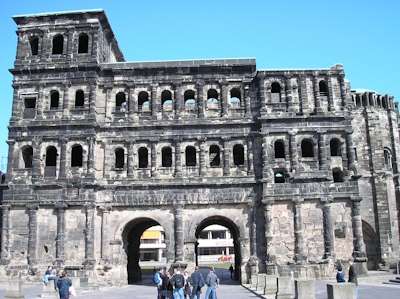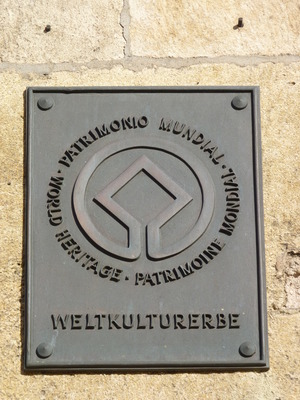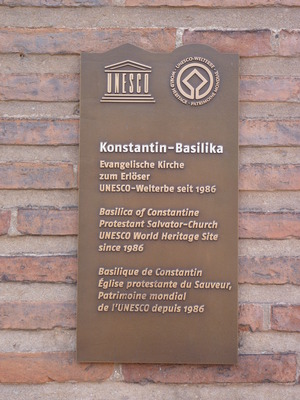Trier

The Roman Monuments, Cathedral of St. Peter and Church of Our Lady in Trier are the testimonies of a Roman colony and its recognition of Christianity.
Trier became a Roman colony in the first century CE and until now holds the best remaining collection of Roman monuments north of the Alps, such as the Porta Nigra. It was a large city, at the trading crossroads between major towns in France and along the Rhine, and the seat of prefects and during the reign of Constantine even the vice-emperor (Caesar) of the Western Empire. He also introduced Christianity. The Cathedral of St. Peter and the Church of Our Lady are both early church buildings.
Community Perspective: It’s a magnificent place and it can keep you occupied for a day as there is so much to see. This site is a bit under-reviewed, although the regional museum (Rheinische Landesmuseum Trier) and the birthplace of Karl Marx are recommended in addition to the Roman monuments.

Map of Trier
Community Reviews
NoahFranc
Trier had been on my bucket list for a long time, as a history buff, and it was a treat to finally be able to go there and go bit by bit through the extensive Roman ruins there. What remains of the bathhouse is surprisingly well-managed and allows one to get a sense of the size of the old Roman baths. Plus, it was cool to be able to walk through what would have been the underground service levels of the facility. The Black Gate well deserves its iconic status, as it's one of the best preserved Roman structures outside of the Mediterranean region.
Jakob Frenzel

August 2018 - after our trip to France we finally arrived Germany again. The last few days we still wanted to visit the WHS sites that are on the road. And there were some more than we expected.
Trier is one of the oldest cities in Germany. The WHS is a combination of the roman and medieval sites, a nomination that would propbabaly not work anymore. But both are definitely worth a trip to Trier. Besides it is the birth town of Karl Marx, which explains the high number of chinese tourists. We visted the Porta Nigra, the roman Bath, and the medieval cathedrals. Great day, great visit, and good food and wine. There are also two breweries were old colleagues are working. So we had to make stops at both of them as well. on the other Mosel shore there is a great campground from which we could overlook the city.
The next day we continued along the Mosel and straight to Upper Rhine Valley.
Clyde

Trier is the oldest city in Germany and packed with Roman monuments and sites to see. The city's landmark is the Porta Nigra (Black Gate). Close to the Hauptmarkt there are the Dom (which houses the Holy Robe - on display April 13 to May 13) and the Church of Our Lady. Further ahead are the Imperial Roman Baths and the Evangelical Lutheran Church which are worth viewing. A great day trip and worth the overnight stay to see the sites without the tourist groups early in the morning.
Kevin
Trier is full of monuments worth seeing. Often overlooked is the town square just up the street from the Porta Nigra. This square turns into a wonderful Christmas Market during December with some of the best food in the country. The town square is also a street or two from St. Peter's Cathedral which is a great example of Romansque architecture. It houses the holy tunic of Christ. I enjoyed the city immensely. If you want to have a walk that you will enjoy, walk through the Kaiserthermen (Roman Baths) or the Ampitheater. Remember the Ampitheater goes down under as well.
Ian Cade

I liked Trier and was surprised by the amount of high quality monuments in the city. The Porta Negra is very impressive, the Dom is stunning for its importance and its holy relic, a tunic supposedly worn by Christ. Then there is the Basilica of Constantine which is impressive for its age, the massive interior and architectural importance as being a forbearer to the Romanesque movement. The Amphitheatre is a little way out side the city walls but is quite large and provides a great place to sit and have a sandwich or run around like a school child (I opted for both with the emphasis a bit too much on the later!)
Not part of the UNESCO site is the birth place of Karl Marx! There is not much there, but it is nice to see none the less.
Trier has enough to occupy you for a day trip and makes a great one from Luxembourg as it is only about 30 minutes by train.
Jim Humberd
Germany’s capital of Roman Antiquity is a magnificent surprise. Located astride the Mosel River about six miles from the Luxembourg border, Trier is little known to most travelers who vacation in Europe, but it should be one of Germany’s most visited cities.
The oldest city in Germany as well as one of the oldest and most interesting on the continent, one motto says, “Before Rome, there was Trier.” Legend says that Trier was founded in 2000 BC (1300 years before Rome), and the Romans didn’t arrive until 14 BC. In 41 AD the Roman writer, Pomponius Mela, called Trier “urbs opulentissima,” a very opulent city.
… … in Trier while we walked just 2,000 steps, we witnessed and enjoyed 2,000 years of history.
From my book Invitation To Germany (google)
Els Slots

Trier is a small city in southwest Germany, very close to Luxemburg. It has an excellent location along the Moselle River. At first sight, it looks like a 'normal' German town, but you don't have to walk far to come eye to eye with Trier's Roman heritage. There's even so much of it that you get the impression that by accident you've been stranded in a German town in Italy.
There's a lot to see here, so I'll name some of the highlights. The large Dome of course, and the baths. And, somewhat out of the center of town, the huge Amphitheatre.
Really interesting also is the regional museum. One room there exhibits large mosaics in good condition that have been found in Trier. At the heart of the museum, an ornamented light blue grave monument is the centerpiece of the attraction. How beautiful the streets of Trier must have looked in Roman Times!
Klaus Freisinger
Trier is the oldest city in Germany and there was a time when it was the second most important city in the Roman Empire after Rome itself - and it shows. I have rarely seen a city with such an impressive array of monuments from Antiquity onwards through many time periods up to the present day - a veritable cross section of European history that is remarkably well preserved (sometimes it helps to be off the beaten track). Of course, Roman and medieval monuments dominate the scene, especially the world-famous Porta Nigra (don't neglect to go inside), the cathedral and the Church of Our Lady next door. The city's history is especially connected to Emperor Constantine the Great and the conversion of the Empire to Christianity. I visited Trier for the huge exposition on Constantine on the 1700th anniversary of his marriage in Trier, which was great, but the city itself impressed me even more.
Community Rating
- : Craig Harder Ali Zingstra BobSmithseestheworld George Gdanski Thomas Harold Watson Aspasia Joe Kuri Mikita M Yevhen Ivanovych Rafał Kałczuga Ming_9734 Awestix
- : Roman Raab Zhenjun Liu KoenigMarke Tarquinio_Superbo Ljowers CeeCeeSR Bropyk
- : Klaus Freisinger David Berlanda Jakob Frenzel Jon Bauer Khuft Philipp Peterer João Aender Juha Sjoeblom Xiquinho Silva FK M. Huineman de la Cuadra Hammeel Dwight Zehuan Xiao Tevity Dsch2oman@me.com SirLoydd Ailton007 Christoph Preiki Sebasfhb Kbtwhs Juropa Shoaibmnagi Adrian Turtschi Ralf Rotheimer Max Ih0000 NoahFranc Manuelfunk Gautamiyer23
- : Frederik Dawson Gary Arndt Martina Rúčková Svein Elias Chenboada John Smaranda Daniel Gabi J. Stevens Shandos Cleaver Antonio J. Alexander Lehmann Christravelblog MaxHeAnouBen Cluckily Lucio Gorla Travel Addicts Mohboh Mademmer WalGra MoPython Inomusay Dutchnick GerhardM J_neveryes DutchHorn MichaelH Sturuss
- : Els Slots Smeets Peter Daniel C-Hazard Peter Lööv Ivan Rucek Hubert Jan Zimmermann Wojciech Fedoruk Cezar Grozavu Clyde Stanimir Randi Thomsen Stanislaw Warwas Argo Kevin247 Purrfect JobStopar Astraftis Mahuhe Tingmelvin Alikander99 CugelVance Isabellemarais JessicaDS
- : Solivagant Ian Cade Szucs Tamas Nan Nolan B. VLabhard Dorejd DavidS Philipp Leu Csaba Nováczky
- : Walter Zoë Sheng Jean Lecaillon Mstrebl1990
- : Sachin
Site Info
- Full Name
- Roman Monuments, Cathedral of St. Peter and Church of Our Lady in Trier
- Unesco ID
- 367
- Country
- Germany
- Inscribed
- 1986
- Type
- Cultural
- Criteria
-
1 3 4 6
- Categories
- Archaeological site - Ancient Rome
- Link
- By ID
Site History
2000 Name change
From "Roman Monuments, Cathedral and Liebfrauen-Church in Trier" to "Roman Monuments, Cathedral of St. Peter and Church of our Lady in Trier"
1986 Inscribed
Site Links
Unesco Website
Official Website
Related
Connections
The site has 28 connections
Art and Architecture
Constructions
Damaged
History
Individual People
Religion and Belief
Timeline
Trivia
WHS Hotspots
WHS Names
WHS on Other Lists
World Heritage Process
Visitors
512 Community Members have visited.
The Plaque
 (photo by Clyde)
(photo by Clyde) (photo by Clyde)
(photo by Clyde)